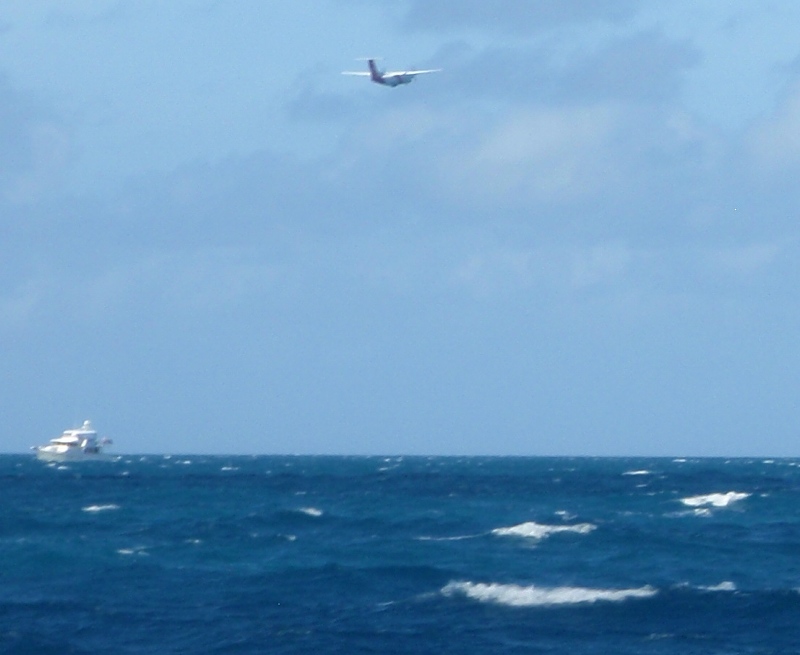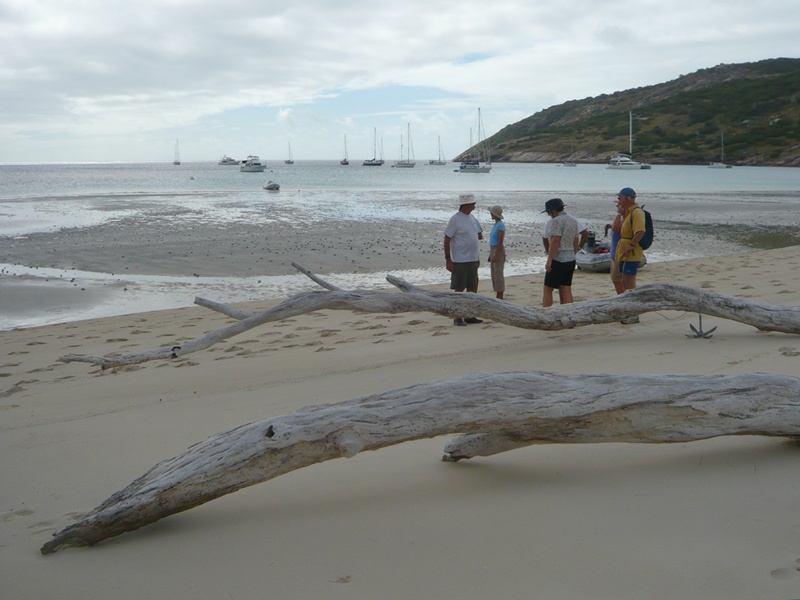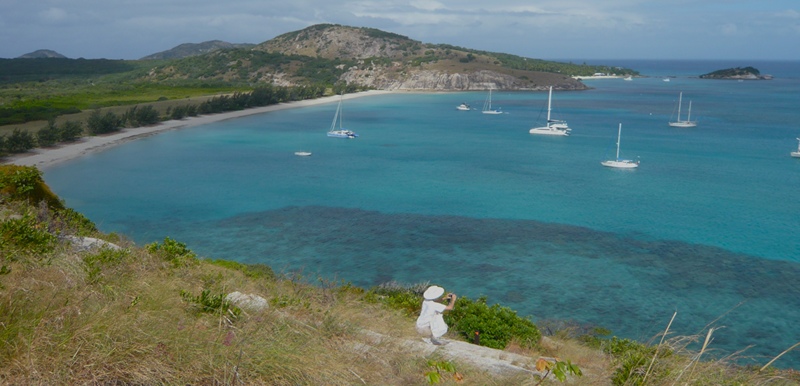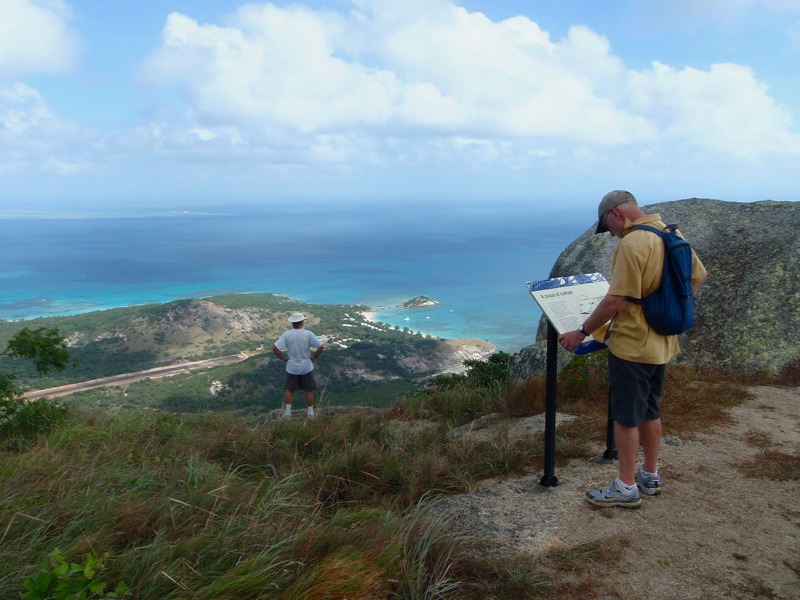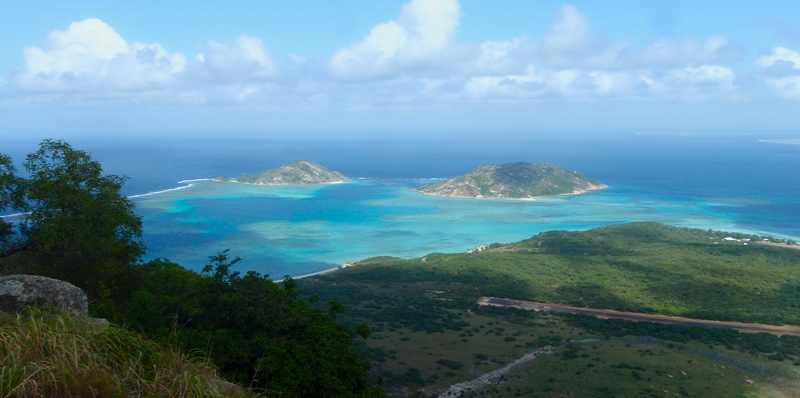Death of a Camera - Lizard Island, Queensland, Australia

Harmonie
Don and Anne Myers
Sat 17 Jul 2010 02:23
|
14:39.604S 145:26.953E
Our last respite. Lizard Island was the last
place we stayed more than one night before the long slog over the top of
Australia. Getting to Lizard Island was a breeze on a mostly beam reach
for the 40 miles we sailed from Cape Bedford. We arrived on June 11th
and stayed through the 13th.
This is the place all boaters stop when
heading north (or heading south for those who like to buck the
normal sailing system). We discovered there is good reason for
this. Lizard Island is home to a posh/flash/ritzy resort where
boaters are not welcome, but the tiny indoor/outdoor bar which caters to resort
workers is happy enough to serve us scraggly folk when it's
open. Not only that, but there's an excellent beach, fabulous snorkeling,
a marine research center and a walk up to Cook's Look where a view that rivals
that from the top of the Isle of Pines in New Caledonia can be
found. Here we ran into more boats headed for Indonesia and found
ourselves nearly surrounded by Americans. An unusual circumstance for
us, and one we haven't found ourselves in since the Caribbean. No
worries though, there were still plenty of Aussies, Brits, French and
Swedish around to keep the crowded floating neighborhood properly
balanced.
Lizard Island was aptly named by Captain
Cook. We saw plenty of big lizard tracks in the sandy road on the way to
the marine research center where several of the staff were carrying
out experiments on shrimp to learn more about the crustacean's superior
eyesight. Apparently shrimp see beyond the visible spectrum.
Good thing they're dead when humans eat them in Australia where
more often than not their heads are still attached. It's bad
enough when their beady little black eyes stare lifelessly up at you
while you rip their heads off, but it would be a lot worse if those beady little
eyes were alive and seeing. If I'd known about this superior eyesight
thing, I might have felt more guilt while washing the few wayward
eyeballs down the drain that always seem to detach themselves from the rest
of the head during the cleaning process.
Picture 1 - The first of many Australian Customs
flybys. In this case they were flying over Storyteller. It
wasn't long before they also buzzed Harmonie. Each flyby was followed
by a stern call on the VHF radio, "White-hulled sailing ketch in approximate
position ___ __ latitude and ___ __ longitude, this is the Australian Coast
Watch!" We would respond, after which they would go through the
usual litany of questions. "What is the name of your vessel? Where
is your home port? Where was your last port of call? What is your
next port of call? How many people are on board?"
Etc., etc. It didn't seem to matter that the Australian
government already has our entire itinerary on file with our visas, or that
we have called customs to report our position at every Australian port
of entry, or that we have noted our position on the
appropriate postcard and sent it to customs every three
months. As we sailed between Mackay and Darwin, we experienced three
flybys, one radio call and one personal visit while at anchor. The record
was three inquiries in two days. We've decided Australia wins
the prize for the most intense border watch system (with a small exception
for that one slightly frightful encounter with the well-armed Colombian Coast
Guard in the dead of night one hundred miles off the coast of Colombia
on our way to Ecuador in 2008).
Picture 2 - Ray, Sue, Don and I on the beach at low
tide getting ready for the marine research center trek.
Picture 3 - On the way up to Cook's Look.
That's me capturing the boats at anchor while Helen captured me capturing the
boats at anchor. The water was so clear (yes! clear water!) details of the
reef directly below the cliff could almost be seen from this
height.
Picture 4 - Helen at the top of Cook's Look.
It's tradition for all visitors to add a rock to the pile upon
arrival.
Captain Cook, frustrated at his inability to break
free into deep water from the confines of the Great Barrier Reef
and the hazards it presented to a wooden boat sailing with no engine
through uncharted waters, climbed to the highest point on Lizard Island in hopes
of seeing a clear path through the reefs. He didn't. Lizard
Island is surrounded by reefs and the hefty southeast trade wind
constantly picks up moisture from the ocean turning
it into what's referred to as 'trade wind haze', which results in very
poor visibility, even on a clear day. Of course Captain Cook did
eventually find his way out of the Great Barrier Reef, through the Torres Strait
and back to England. A good thing too since all these places would be
lacking names if it weren't for him. Oh, and Australia might not be the
country it is today if Captain Cook hadn't returned safely to
England.
Picture 5 - Ray and Don taking in the view from
Cook's Look. Note how hazy the horizon is. It's tough to
tell from this picture, but the trades were blowing a good 25 to 30
knots at the top and nearly as much in the anchorage below. Lots of trade
wind haze.
Picture 6 - The Lizard Island airstrip and the Blue
Lagoon.
Thanks to Helen for pictures 2 and 3.
We would have liked to stay a little longer at
Lizard Island, but the high winds made for rough dinghy rides and even rougher
snorkeling. Rough snorkeling. Now we come to the sad story of
the death of a camera. Lizard Island is known for its fringing
reefs, so Helen, Ray, Sue, John and I battled through the wind waves
in Storyteller's sturdy dinghy to snorkel the reef a short distance
from shore. Floating with the wind and current through water filled
with churned up sand, we bounced in the short, but insistent
waves along the edge of the reef. Even with all the
sand swirling through the water, it was still obvious that the reef,
corals, fish, giant clams, all of it, were incredible - some of the best we've
seen. Camera in hand, I started snapping pictures. One, two, two and
a half....oops! part of the camera fell off and the LCD
screen popped to a complete blank. The screen was black. The
part that fell off sat in my hand. In it's absence, a gap existed around
the lens. Big, colorful fish swam by as I stared at the black screen and
the part sitting in my hand. The fish didn't care about my dead
camera. They were probably mocking me as they slid by, but I'll never know
for sure since I couldn't capture their expressions on camera for future
scrutiny. It was a good camera. Despite the fact that it's snazzy
paint job started to peel the very first time I took it under water a mere
year and a few months ago. I cared for it well and except for the
peeling paint and the two spots on the lens I had to constantly photoshop out of
every blue sky image, it served us well. But since when is
a top end underwater camera only good for ten dunks? Ten. That's it
and the thing falls apart on its first dunking of the season?
It's possible Olympus will hear from us soon. In the meantime, we dug
out Don's old digital camera. It's vintage 2003 and we used it for Season
1 of our trip, but it doesn't quite live up to the standard set by its
younger dead cousin. Apologies in advance for the less than stellar
images covering the remainder of our sail to Darwin. Apart
from of the images donated by Helen, that is.
Anne
|
